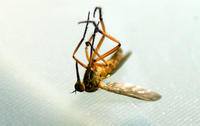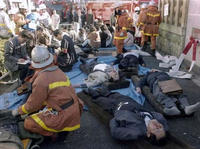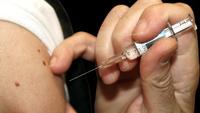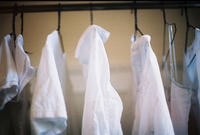-
Wisconsin hospitals ahead of the curve
In the 2009 H1N1 flu epidemic while public health officials across the United States were contending with shortages of basic supplies like ventilator masks, Wisconsin health authorities were able smoothly to weather the storm thanks to its stockpiles of protective clothing, emergency planning, and advanced training
-
-
Japan halts shipments of radioactive beef
The Japanese government is coming under fire for only halting shipments of contaminated cattle now, four months after the 11 March earthquake and tsunami that led to the nuclear crisis at the Fukushima Daiichi atomic energy station; authorities recently discovered that 637 cattle had been fed hay contaminated with radioactive cesium and then shipped from farms in northern prefectures including Fukushima
-
-
Mosquitoes' last supper

Inhibiting a molecular process cells use to direct proteins to their proper destinations causes more than 90 percent of affected mosquitoes to die within forty-eight hours of blood feeding; the approach could be used as an additional strategy in the worldwide effort to curb mosquito-borne diseases like dengue fever, yellow fever, and malaria
-
-
Antibacterial stainless steel created
Materials scientists have devised a way of making stainless steel surfaces resistant to bacteria; by introducing silver or copper into the steel surface — rather than coating it on to the surface — the researchers have developed a technique that not only kills bacteria but is very hard and resistant to wear and tear during cleaning
-
-
PositiveID releases groundbreaking new biothreat detector
PositiveID Corporation recently unveiled its new Multiplex BioThreat Assay, which the company says is the first of its kind; according to PostiveID, its latest device is the first commercially available detector that can diagnose up to six bio-threat organisms in the Centers for Disease Control’s category A and B lists in a far shorter time than existing methods
-
-
To stem the spread of disease schools reconsidering attendance policies

Due to public health concerns, a growing number of schools across the United States have stopped giving students awards for their attendance record; in an effort to maintain their attendance records, many students likely went to school while sick, greatly increasing the risk of infecting others; following the H1N1 flu outbreak in 2009, many school districts across the United States began reconsidering their attendance policies and many eventually chose to stop awarding students with perfect attendance records
-
-
Natural enzyme can defend against terrorists' nerve agents

Chemicals called organophosphates, found in common household insecticides, can be just as harmful to people as to insects; organophosphates could be released on an industrial scale, through an act of terror or accident, attacking the nervous system by inactivating an enzyme called acetylcholinesterase (AChE); scientists are devising drugs to treat and prevent the toxic effects of organophosphates and related chemicals
-
-
Satellites could predict next cholera outbreak
With cholera making an unlikely resurgence, catching countries like Haiti and Pakistan by surprise, public health officials are exploring the potential for new technology to help stem the spread of future outbreaks; each year the disease affects three to five million people and claims more than 100,000 lives; researchers believe that satellite images of oceans could help forecast when a cholera outbreak is likely to strike
-
-
Natural antibody brings universal flu vaccine closer

Annually changing flu vaccines with their hit-and-miss effectiveness may soon give way to a single, near-universal flu vaccine, according to a new report from scientists at the Scripps Research Institute and the Dutch biopharmaceutical company Crucell; they describe an antibody which, in animal tests, can prevent or cure infections with a broad variety of influenza viruses, including seasonal and potentially pandemic strains
-
-
Nano detector spots deadly anthrax
The average time of detection of an anthrax attack by current methods — the time required for DNA purification, combined with real-time polymerase chain reaction (PCR) analysis — is sixty minutes; a new, automatic, and portable detector takes just fifteen minutes to analyze a sample suspected of contamination with anthrax
-
-
Microalgae : Texas' next big cash crop
There are an estimated 200,000 to 800,000 species of microalgae — microscopic algae that thrive in freshwater and marine systems; scientists say microalgae offers a huge, untapped source of fuel, food, feed, pharmaceuticals, and even pollution-busters; it is set to be Texas’ next big cash crop
-
-
New technology makes textiles permanently germ-free

University of Georgia scientist develops a new technology that makes textiles permanently germ-free, targeting healthcare-associated infections; the new material effectively kills a wide spectrum of bacteria, yeasts, and molds that can cause disease, break down fabrics, create stains, and produce odors
-
-
Sprouts blamed for U.S. Salmonella outbreak
After infecting more than 4,000 people across Europe and North America, sprouts have been blamed once more for a food-borne outbreak, this time in the United States; on Tuesday the Centers for Disease Control and Prevention (CDC) announced that sprouts were the source of a Salmonella outbreak which has sickened more than twenty people across five states including Washington, Montana, and Idaho
-
-
100 Utah employees quarantined after measles outbreak
A measles outbreak has forced a power plant in northern Utah to keep hundreds of its employees at home; last week an employee at the Intermountain Power Agency power plant in Delta, Utah tested positive for measles prompting officials to order an estimated 100 employees and contractors born after 1957 to stay home until they can show that they have been fully vaccinated
-
-
China pushes for food security at G20 agriculture meeting
At a G20 meeting of agricultural ministers, Chinese officials urged their counterparts to address food security; China said addressing market volatility and food security is a top priority and that leaders should come to an agreement on how to handle soaring food prices; in recent years natural disasters, increases in demand, international speculation, and the increased use of biofuels have all caused food prices to spike
-
More headlines
The long view
We Ran the C.D.C.: Kennedy Is Endangering Every American’s Health
Nine former leaders of the Centers for Disease Control and Prevention (CDC), who served as directors or acting directors under Republican and Democratic administrations, serving under presidents from Jimmy Carter to Donald Trrump, argue that HHS Secretary Roert F. Kennedy Jr. poses a clear and present danger to the health of Americans. He has placed anti-vaxxers and conspiracy theorists at top HHS positions, and he appears to be guided by a hostility to science and a belief in bizarre, unscientific approaches to public health.
